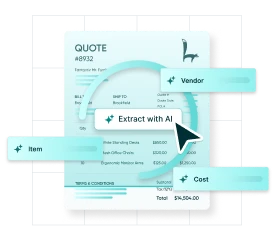Supplier Optimization Guide: How to Build a High-Performing Supply Base
As companies grow, their supply base often expands in parallel. More suppliers can mean more options — but it also increases complexity, costs, and risks. In fact, according to Industry Star, roughly 80% of a company’s cost of goods sold (COGS) comes from just 20% of its suppliers. This highlights the importance of focusing on the right supplier relationships.
That’s where supply base optimization comes in. The goal isn’t simply reducing the number of suppliers, but ensuring your organization is investing in those that deliver the most value. Done well, supply base optimization helps reduce costs, improve efficiency, strengthen collaboration, and drive revenue growth.
Before we dive into the steps, let’s clarify the basics.
What is supply base optimization?
Supply base optimization is the strategic process of managing and refining your supplier network so you can focus on the partners that add the most value. Instead of spreading resources across dozens or even hundreds of vendors—many of whom may be inactive, redundant, or underperforming—the aim is to create a leaner, more resilient, and higher-performing supply base.
Importantly, supply base optimization isn’t just about cutting numbers. A well-managed supply base leads to stronger supplier performance, deeper collaboration, reduced costs, and lower risk exposure across the supply chain. By concentrating on fewer, more capable partners, procurement teams gain better visibility into spend, tighter control over contracts and compliance, and the ability to scale operations with confidence.
6 proven steps for smarter supplier base optimization
Now that you know what supply base optimization is, how do you actually put it into practice? The process requires a clear strategy—one that reduces low-value suppliers while strengthening partnerships with the vendors that matter most.
Here’s a step-by-step approach:
1. Analyze your current suppliers
Start with a comprehensive review of supplier spend, performance, and capabilities. Look back at recent quarters and assess factors such as:
- Last PO issued
- Usage frequency (monthly or quarterly)
- Lead times
- Payment terms
- Delivery and quality performance ratings
- Supplier audits—onsite or virtual—can add valuable context.
Group suppliers into three categories:
A: High-performers
B: Mid-tier suppliers that miss some goals
C: Suppliers unable to meet current or future needs
2. Define clear selection criteria
Decide which suppliers you want to retain long term. Criteria may include product quality, consistency, alignment with business objectives, certifications, or operational maturity. A strong supplier onboarding process can also help ensure new vendors meet these standards before entering your supply base.
3. Track performance against KPIs
Establish measurable procurement benchmarks such as on-time delivery, responsiveness, order accuracy, and quote turnaround. Use procurement software to automate tracking and maintain performance dashboards, rather than relying solely on manual data collection.
4. Rationalize your supply base
Use the data to identify your most valuable suppliers. Vendor management is made much easier by reducing the number of active vendors and consolidating purchasing through approved PunchOut catalogs. This helps eliminate redundant, dormant, or underperforming relationships. Rationalization strengthens spend leverage and simplifies procurement oversight.
5. Create a transition plan
Getting leadership buy in is key. Build a transition roadmap with timelines, budgets, and cross-functional input. Secure updated agreements with chosen suppliers and renegotiate terms where needed. Transparent communication ensures internal teams and suppliers are aligned during the shift.
6. Invest in ongoing supplier management
Optimization doesn’t end with rationalization. Continue to monitor supplier performance, revisit contracts, and encourage continuous improvement. Strong supplier relationships build trust, increase transparency, and open the door to joint innovation.
Creating a manageable supply base with supply base rationalization
As organizations grow, so does their supply base—especially in companies with multiple locations or decentralized purchasing. Managing an expanding supplier network requires significant resources: every RFQ, PO, invoice, or supplier performance review translates into time and cost. The larger the supply base, the harder and more expensive it becomes to maintain effectively.
That’s where supply base rationalization comes in. This process focuses on identifying the right number of suppliers with the right capabilities to meet your organization’s needs. While rationalization is about reducing and refining the supplier pool, supplier optimization goes a step further by improving performance, collaboration, and alignment with the suppliers you retain. Together, they create a foundation for more strategic initiatives like vendor procurement, where organizations can maximize value through smarter sourcing and stronger supplier partnerships.
A poorly managed supply base creates risk. Underperforming suppliers, limited capacity, or financial instability can all disrupt the supply chain. By systematically eliminating or replacing these suppliers, procurement teams build a leaner, more resilient supplier base, one that is easier to manage and better aligned with long-term business goals.
Here are some proven approaches organizations use to create a more manageable supply base:
1. Arbitrary reduction
Some companies cut their supplier list in half (or more), at the direction of senior management. While this approach is fast, it’s risky. Without clear criteria, strong suppliers may be eliminated alongside poor performers, weakening the supply chain. Arbitrary reduction should only be used with caution, if at all.
2. Top spend approach
Often, 20% of suppliers account for 80% of total spend. Some businesses rationalize their supply base by keeping these “top-spend” vendors and cutting lower-tier suppliers. The downside: high-spend vendors aren’t always the best performers, and low-spend suppliers may be highly capable. This strategy requires careful review to avoid blind spots.
3. Best-in-category selection
Suppliers with deep expertise in a specific category (e.g., machine parts, electronics, raw materials) are natural candidates to remain in your supply base. However, multi-category suppliers may excel in one area but not in others—retain them as prime suppliers where they’re strongest and backups where they’re not.
4. Sole-source suppliers
Some vendors have unique capabilities essential to your business. They should be retained, but relying solely on them is risky. Without a backup, a single disruption—plant damage, capacity issues, price hikes—can cripple your supply chain. Sole-source suppliers should be managed with contingency plans in place.
5. Quality and delivery thresholds
A simple, effective approach is setting clear performance standards and tracking KPIs (e.g., on-time delivery rates, quality defect levels). Suppliers that consistently meet or exceed these thresholds remain; those that don’t are replaced. This approach rewards continuous improvement and ensures reliability.
6. Dormant or inactive suppliers
Many companies keep vendors on file that haven’t received a PO in months—or even years. Regularly auditing your vendor database and removing inactive or duplicate suppliers keeps your supply base lean and reliable.
7. Ongoing maintenance
Rationalization isn’t a one-time project. After eliminating underperformers, continually review and refresh your supply base by adding high-performing partners and replacing “good” suppliers with “better” ones. The ultimate goal is to build a manageable, resilient, and optimized supply base that supports long-term business growth.
Benefits of supply base optimization
Cost reduction
A leaner supplier base reduces overhead. With fewer vendors to manage and synchronized supply chain systems, organizations save money on warehousing, transportation, logistics, and inventory management. Concentrating spend with strategic suppliers also improves leverage in contract negotiations.
Better visibility and decision-making
With fewer suppliers, it’s easier to see where money is going and how suppliers are performing. A streamlined supply base provides clearer data, helping teams spot underperformers, identify bottlenecks, and make faster, more informed decisions based on real-time insights.
Stronger collaboration
Managing a smaller, high-performing group of suppliers creates room for deeper partnerships. Technology such as automation and analytics enhances collaboration, improves communication, and provides visibility across operations. The result: reduced inventory, faster fulfillment, and higher profitability.
Greater control and reduced risk
Optimization gives leaders tighter control over forecasting, cash flow, and compliance. With fewer suppliers to monitor, it’s easier to enforce policies, track KPIs, and ensure accountability. This reduces risks tied to inconsistent quality, missed deliveries, or financial instability.
What’s next
Supply chains are constantly evolving, but customer expectations remain the same: high-quality products delivered on time at a fair price. Optimizing your supply base helps meet those expectations while improving efficiency and resilience.
When assessing your supplier base, ask:
- Are there redundancies in your supply base?
- Do you have underperforming suppliers?
- Are there gaps (e.g., not enough suppliers in critical categories)?
- Do you have too many suppliers to manage effectively?
The right balance looks different for every organization. What matters most is building a cost-effective, efficient, and resilient supply chain,supported by strong supplier relationships.
Looking to modernize your procurement process? Download our 2025 Buyer’s Guide to learn what to look for in supplier management tools.

Preview AI Intake for Orders
Take the product tour to see how the new intake experience works.
